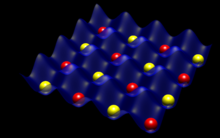Summary
Quantum information processing seeks to use the features of quantum physics to accomplish otherwise intractable computational tasks. The two main thrusts of quantum information research we are pursuing are quantum simulation and quantum computation. Quantum simulation aims to use one well-controlled quantum system to simulate another complex many-body quantum system, where classical methods to model the system fail. Quantum computation is a robust (and technically challenging) extension of this endeavor, where individual quantum systems are used to encode arbitrary quantum information, which may then be utilized for a wider range of computational tasks. We are pursuing both of these ends using ultracold neutral atoms confined in optical traps.
Description

Optically trapped ultracold atoms are a leading candidate for both quantum simulation and quantum computation. Atoms trapped in ultra-high vacuum are an excellent quantum memory, due to their long coherence times and isolation from environmental perturbations. It is advantageous to use the mechanical force of light to trap these atoms, as this allows atoms in any combination of spin-states to be simultaneously confined. The flexibility to trap, interrogate, and manipulate atoms in a range of quantum states is essential for simulating many effective spin Hamiltonians.
In addition, optical traps offer a high degree of flexibility in the trapping arrangement and geometry. In particular, an optical lattice may be created by interfering two (or more) laser beams to form a standing-wave pattern of light, where atoms are confined at each anti-node in this array to produce an artificial crystal. In contrast to the crystal structures encountered in nature, we can tune the confinement, tunneling, and interactions of the atoms trapped in the optical lattice, making it ideal for simulating complex quantum many-body physics. Moreover, each atom in the lattice could be treated as a single bit of quantum information. The interactions between atoms in neighboring lattice sites could then be tailored to perform quantum logic operations. Arbitrary control of these operations may allow atoms confined in an optical lattice to be used for generalized quantum computation.
In the Laser Cooling group, we have two neutral atom experiments exploring complimentary paths towards quantum simulation and quantum computation:
Rb I: Results from this lab include patterned loading of atoms into an optical lattice, observation of the 2D superfluid-to-Mott insulator transition, and the implementation of a controlled two-qubit interaction. More recently we have demonstrated certain "magic" conditions where the differential shift of spin-states (used as qubits) can be minimized, and we benchmarked our single-qubit control to a fidelity of a few parts in 104. Essential to much of our recent work has been the use of a "double-well" optical lattice.
Rb II: A novel tool for quantum simulation is being developed in this lab: synthetic gauge potentials for neutral atoms. Other efforts include full characterization of the 2D Mott insulator transition, and experiments using magnetic Feshbach resonances, where the interactions between atoms can be controlled with an external field.

